Purple weed has always been a favorite among stoners and growers, known for its eye-catching shades from soft lilac to deep violet. This unique coloration doesn’t just make purple weed look good, but it also raises questions about what makes it special and what causes its color.
Lately, there’s been a lot of talk about the benefits of purple weed, its potency compared to other strains, and the science behind its color. With more stoners gravitating towards these varieties, the demand for purple strains has gone up. This has encouraged growers to get better at creating conditions that bring out those sought-after purple traits.
In this blog, we’re going to take a closer look at why purple weed is so appealing, diving into its genetics, the environmental factors that influence its color, and how it differs from the more common green cannabis in both looks and effects.
What Makes Weed Purple?
The beautiful purple color of a purple weed strain isn’t just visually appealing; it’s actually caused by a mix of genetics and environment.
The key to the purple color lies in anthocyanins, a type of flavonoid found in many plants, including cannabis. Anthocyanins are responsible for the red, purple, and blue colors of fruits and vegetables.
The coloration process of purple weed is largely influenced by the plant’s genetics. Some cannabis strains naturally contain higher levels of anthocyanins. However, the visibility of these pigments is also heavily dependent on external environmental conditions, particularly during the flowering stage.
Cooler temperatures can suppress chlorophyll production (the green pigment) and allow the purple pigments to become more pronounced, leading to the striking coloration that makes these strains so distinctive.
Now, anthocyanins do more than just contribute to the plant’s aesthetic appeal; they also offer protective benefits to the cannabis plant. These compounds help shield the plant from various environmental stressors such as ultraviolet light, cold weather, and pests.
In terms of effects on the user, while anthocyanins themselves don’t necessarily enhance the potency of the weed, they are known for their antioxidant properties, which could contribute to the overall therapeutic effects of purple weed flower strains.
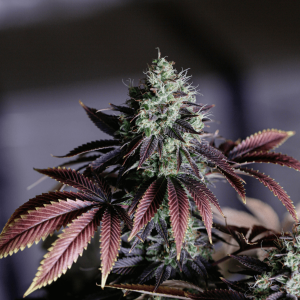
The Genetics of Purple Weed Strains
Exploring why some weed strains have attractive purple colors reveals a mix of genetics and precise cultivation.
Some cannabis strains are genetically predisposed to produce more anthocyanins, which gives them their purple color. In the following sections, we’ll look at some of the most popular purple weed strains and the science behind their genetics.
Common Purple Weed Strains
- Granddaddy Purple: A classic among purple marijuana strains, known for its potent effects and sweet, berry-like aroma. Granddaddy Purple is a staple in the purple weed category, beloved for its deep violet leaves and relaxing effects.
- Sour Grape: This strain combines the tangy, sour flavor of grape with a visually striking purple hue. Sour Grape is favored for its balanced effects that cater to both relaxation and a gentle euphoric high.
- Purple Punch: Bearing a dessert-like name, Purple Punch lives up to its moniker with a sweet, fruity taste and a beautiful purple appearance. It’s often sought after for its ability to soothe and relax.
- Purple Thai: A more vibrant strain that showcases vivid purple streaks against a backdrop of green. Known for its uplifting and energizing effects, Purple Thai is a great choice for daytime use.
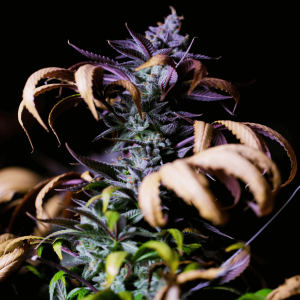
Genetic Manipulation vs. Natural Occurrences
The appearance of purple in weed can occur naturally, due to the genetic predisposition of certain strains to produce high levels of anthocyanins.
However, with the growing demand for purple cannabis, some cultivators have turned to genetic manipulation to enhance or introduce purple hues in strains that might not naturally express them. This can involve selective breeding techniques, where strains known for their purple coloration are bred together to reinforce the trait in future generations.
While some purists prefer the natural occurrence of purple weed, advancements in genetic manipulation offer a way to experiment with coloration while potentially enhancing other desirable traits, such as flavor profiles or potency levels.
Growing Purple Weed
To successfully grow purple cannabis, understanding the ideal conditions that bring out its vibrant colors is crucial.
While genetics play a significant role in determining whether a strain can turn purple, specific environmental factors during the growing stage can significantly influence the expression of these colors.
Ideal Growing Conditions
The key to achieving that sought-after purple hue lies in controlling the growing conditions to favor the expression of anthocyanins.
Generally, a stable environment with a careful balance of nutrients, pH level, and moisture is essential for the healthy growth of cannabis plants, including purple strains.
Ideal Temperature
Temperature plays a pivotal role in the development of purple colors in cannabis. During the flowering stage, cooler nighttime temperatures are critical for decreasing chlorophyll production, the pigment responsible for the plant’s green color.
Lower temperatures help to reveal and accentuate the purple pigments by allowing the anthocyanins to become more prominent.
It’s suggested to slightly lower temperatures during the night cycle in the flowering phase but be mindful to avoid extreme cold, as it can stress the plant and affect its growth.
Ideal Lighting
While the type of light doesn’t directly influence color change, the intensity and spectrum can impact the plant’s overall health and its ability to express purple hues.
Full-spectrum LEDs are often recommended for indoor growing as they can be more easily controlled to mimic natural sunlight conditions, which is beneficial for the development of purple colors.
However, it’s the temperature rather than the light that plays a more direct role in color expression.
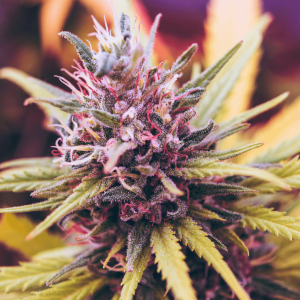
Harvesting Purple Weed
After carefully nurturing the purple cannabis through its growing cycle, ensuring a timely and proper harvest is paramount to preserve its unique coloration and potent qualities.
Identifying the right time to harvest purple weed involves observing the trichomes, which are the tiny, crystal-like structures on the buds. When most trichomes shift from clear to a milky white color, it’s a strong indicator that the cannabis has reached its peak potency.
For strains with purple hues, the coloration of leaves and buds will be visibly richer and more pronounced, showcasing various shades of purple that signal readiness for harvest.
How to Preserve Purple Strains While Harvesting
To maintain the vibrant purple coloration and quality of the buds during harvest, it’s important to handle the plants gently and to dry and cure them properly.
Careful trimming should be practiced to keep as much of the purple leaves intact as possible.
Slow and controlled drying, followed by a thorough curing process in air-tight containers, will not only preserve the purple hues but also enhance the overall aroma, flavor, and potency of the purple buds.
Avoid rushing the drying process as rapid moisture loss can diminish the visual appeal and quality of the final product.
Cultivating Purple Weed: Tips and Tricks
For succthe ssful growth of purple weed, it’s crucial to carefully manage soil nutrients and the pH levels of the growing medium. These factors significantly affect the plant’s natural purple colors, resulting in a more vibrant harvest.
Soil Nutrients and Additives That Enhance Purple Hues
Adding specific nutrients and supplements to the soil can really bring out purple colors in cannabis plants.
Key nutrients like potassium, phosphorus, and magnesium are vital for the plant’s health and for making anthocyanins, which give the plant its purple hue.
Using organic supplements like bat guano, bone meal, and Epsom salts is a great way to provide these nutrients. Also, adding sulphur can boost the purple color by mildly stressing the plant, which increases anthocyanin production.
The Importance of pH Levels in Cultivating Vibrant Colors
Keeping the right pH level in soil is crucial for getting the best nutrient absorption, which affects the color of purple marijuana strains.
Cannabis plants do best in a slightly acidic to neutral pH range, about 6.0 to 7.0. If the pH level goes too far off this mark, the plant might not be able to get the nutrients it needs from the soil, which could mess with its color.
To keep those vibrant purple colors consistent, it’s important to regularly check the soil’s pH and adjust it using natural solutions if needed.
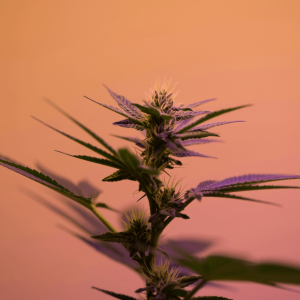
The Aroma and Flavor Profile of Purple Weed Strains
Purple weed strains stand out not just for their eye-catching color, but also for their unique aroma and flavor.
These strains come with a complex mix of scents – a mix of earthy, sweet, and fruity. Many have a strong sweet or berry-like smell, often reminding one of grapes, berries, or other dark fruits. This sweet aroma usually means a rich and satisfying taste as well.
The special terpene profiles in purple weed strains are what give them their distinct flavors, ranging from very sweet and fruity to slight touches of pine or spice.
The Potency and Effects of Purple Cannabis
The potency of purple marijuana strains can widely vary, largely depending on the specific genetics of each variant.
THC and CBD levels in these strains can range dramatically, making some purple strains more suitable for recreational use due to their high THC content, while others with higher CBD levels are sought after for their medicinal benefits.
THC and CBD Levels in Common Purple Strains
Purple strains such as Granddaddy Purple, Purple Kush, and Purple Haze are renowned for their relatively high THC content, often exceeding 20%, which contributes to their powerful psychoactive effects.
On the other hand, strains like Purple Arrow, despite their vibrant coloration, might have a more balanced THC to CBD ratio, appealing to those seeking relief without intense psychoactivity.
Expected Effects and Medicinal Benefits
The effects of consuming purple weed strains can vary, but many users report a pleasant mix of euphoria and relaxation. Strains with high THC levels tend to provide a more intense cerebral high, accompanied by feelings of relaxation and sedation, making them excellent choices for evening use.
In contrast, purple strains with higher CBD content are praised for their potential to alleviate chronic pain, anxiety, and inflammation without producing a strong psychoactive effect.
This versatility makes purple cannabis a favored option among both recreational and medicinal users, catering to a broad spectrum of needs and preferences.
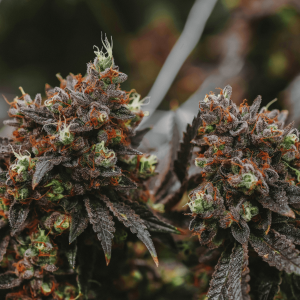
Conclusion
In summary, purple cannabis strains stand out for their vibrant colors, unique smells and flavors, and varied potency levels, making them popular in the cannabis market.
Their rich purple hues, from lavender to deep violet, are not just visually appealing but also indicate careful growing practices, such as precise temperature control and nutrient management.
These strains provide a rich sensory experience, with sweet, fruity, and sometimes earthy aromas and flavors that appeal to many tastes.
The importance of purple cannabis in the market is significant. It attracts both recreational users looking for strong THC effects and medicinal users seeking the benefits of CBD-rich varieties. Its popularity highlights a growing appreciation for the quality, aesthetics, and therapeutic potential of cannabis.
As growing techniques improve and consumers become more knowledgeable, the demand for these visually appealing and potent strains is expected to keep growing. This will further solidify purple cannabis as a top choice for both connoisseurs and casual users.
FAQs About Purple Weed
1. What kind of weed is purple color?
Purple weed refers to cannabis strains that exhibit vibrant purple hues in their leaves and buds.
These colors are a result of the plant’s genetics and environmental factors such as colder temperatures during the growing process, which enhance the production of anthocyanins, pigments that can turn parts of the plant purple.
2. Is purple weed the strongest?
Not necessarily. The color of the cannabis, including purple hues, does not directly correlate with its potency.
Potency is determined by the THC and CBD content of the strain, which varies widely among purple strains. Some purple strains can be exceptionally potent, while others may have moderate effects.
3. What is the purple weed thing?
The “purple weed thing” often refers to the noticeable and appealing purple coloring found in certain cannabis strains.
This characteristic is highly sought after for its aesthetic appeal and is sometimes (mistakenly) associated with higher quality or potency.
The purple coloring is mainly due to genetic factors and the presence of anthocyanins.
4. What are the purple weeds called?
Purple weeds in the context of cannabis are called purple strains. Popular purple strains include Granddaddy Purple, Purple Kush, Grape Ape, Purple Urkle, and the Purple Haze weed strain.
These strains are known for their distinctive purple foliage and sometimes for their unique aroma, flavor profiles, and effects.

 Rewards
Rewards





